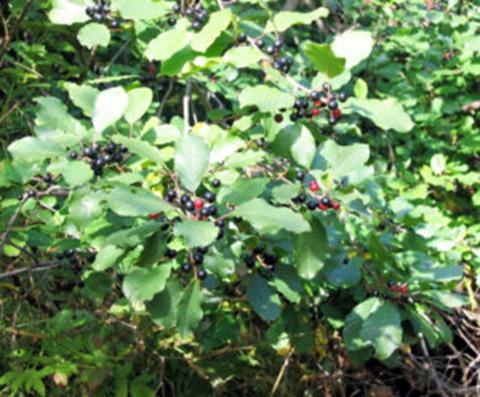Fall is for Invasives Management

While we’re out and about enjoying the final weeks of leaf peeping, we can be taking the opportunity to look for invasive plants hiding in plain sight among the natives. As our maples, birches and other local trees change color, you’ll see persistent green leaves among the autumn hues – often a sign of an invasive plant.
Many invasives will hold their green color long after natives have turned, or even dropped their leaves, photosynthesizing weeks longer than natives that are going dormant for the season. This ecological advantage helps them grow and gain more ground in the forest, farm woodland or city park. Weeks after the native trees are defoliated, the crimson leaves of invasive burning bush can be seen at a distance. Vining bittersweet can readily be seen curling around denuded stems, branches and trunks of trees and shrubs.
Late autumn into early winter is the perfect time to identify and manage invasive plants. They are easier to spot amongst the frost-killed and sleeping natives. Seedlings can be more readily seen once the major canopies are reduced, and we can see through the wooded spaces more freely once the leaves have fallen. Pulling invasives out of the earth won’t disturb the natives as much, as they are already well on their way to a long winter’s rest. If you feel the need to treat with chemicals, there is less live tissue at risk for collateral damage from overspray.
Plant physiology is also on your side for autumn chemical use, as trees and shrubs are busy directing resources to their roots to store them for overwintering. When a cut-stump or cut-and-swipe chemical control method is used (cut off stems and use a dabber to apply herbicide directly to the cut) the natural flow carries the herbicide along to the roots. Spring treatments can sometimes be less effective because the opposite is true- plants are busy pushing resources up and out toward new buds. Fall management is ideal for woody invasives like buckthorn, Autumn Olive and non-native honeysuckles.
Autumn is also perfect for a see-it-pull-it technique often applied to garlic mustard, bittersweet, multiflora rose and seedlings of woody invasives before they get so large that chemical treatment is needed. Also, once the leaves are gone, seeds are also more visible and accessible on invasives, so pick them before they are eaten and spread by wildlife or drop to become seedlings.
Last but not least, think about nuisance plants – not officially invasive, but aggressive in the landscape. Many perennials and some self-seeding annuals fall into this category: tansy, thistle, pokeweed. Remove them before they become more invasives to manage next spring.
Final tips:
Know Your Invasive Plants: Print off this guide and carry it with you.
One Species at a Time: Don’t try to save the world, focus on one thing you can manage well.
Continued Maintenance: It can take a while to get things managed, and wildlife will always plant more for us, so make monitoring part of your walking/hiking routine.
Minimize Disturbance: Disturbed soil is an opportunity for invasive plants to become established. Make sure soil is covered and disturbed areas are checked regularly.
Timing is Important: Disrupt the life cycle of a species for most effective management.
Fill Empty Spaces: A great way to keep invasive species out is to fill open spaces with desirable ones. Replace invasives that you remove with natives to take away the opportunity for invasives to return.
For tips on specific invasives, here are additional resources to download:
UNH Extension website Invasives resource page
Manual Control of Terrestrial Invasive Plants
